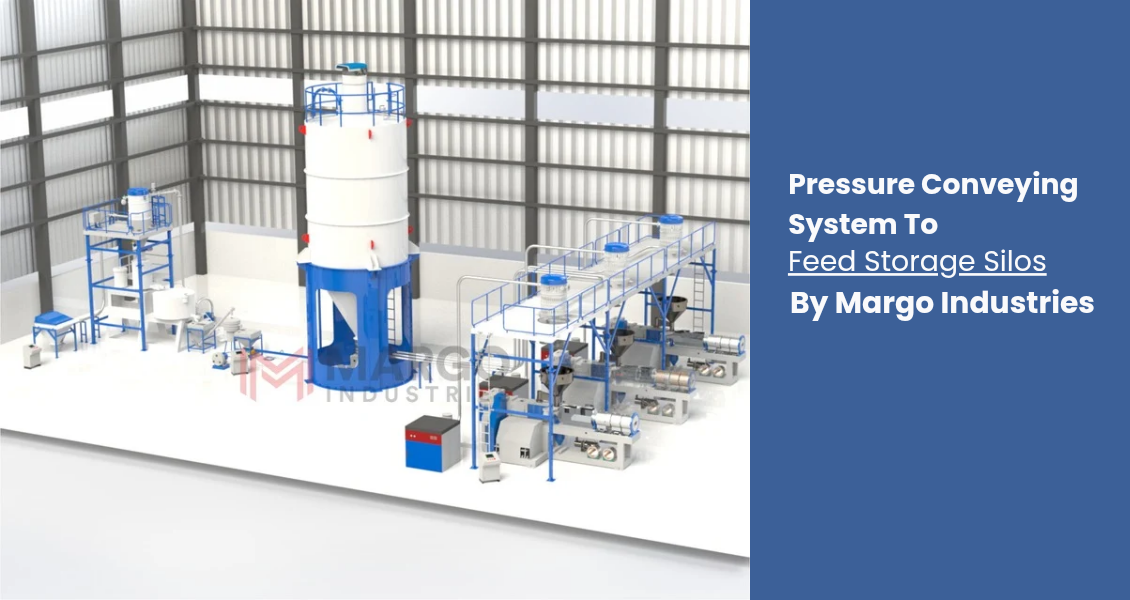
Pressure Conveying System to Feed Storage Silos – Efficient and Reliable Material Transfer Solution
In modern industrial operations, efficient material handling is key to optimizing production workflows. The Pressure Conveying System to feed storage silos offers a cutting-edge solution for transporting bulk materials like powders, granules, and pellets with unmatched reliability and speed. This system uses pressurized air to push materials through sealed pipelines, enabling clean, dust-free, and safe material transfer. Ideal for industries ranging from cement and construction to food, pharmaceuticals, and chemicals, this technology helps businesses improve productivity while maintaining compliance with environmental and safety standards.
What is a Pressure Conveying System?
A Pressure Conveying System is a bulk material handling solution that transports solid materials by applying positive air pressure within a sealed pipeline network. Unlike vacuum conveying systems that pull materials, pressure conveying pushes materials forward using controlled air pressure. This allows for longer conveying distances, higher capacities, and effective handling of heavy, abrasive, or sticky materials. The system consists of a material feeding mechanism, pressure generation equipment (such as compressors or blowers), sealed pipelines, and a discharge unit typically interfacing with storage silos.
Why is Pressure Conveying Important in Bulk Material Handling?
Pressure conveying systems significantly enhance operational efficiency by enabling continuous, high-volume material transfer with minimal human intervention. The enclosed design minimizes dust emissions, which is critical for workplace safety and environmental compliance. Furthermore, pressure conveying preserves the physical integrity of sensitive materials by reducing contamination and degradation risks during transport. Industries relying on bulk solids processing depend on this system to maintain smooth production lines, reduce downtime, and ensure product quality.
Key Features of the Pressure Conveying System
1. Robust Pressure Generation and Precise Control
Equipped with industrial-grade compressors or blowers, the system generates consistent air pressure tailored to the material type and conveying distance. Advanced pressure regulators and sensors maintain optimal flow, preventing blockages and ensuring smooth operation.
2. Sealed, Dust-Free Material Transfer
The entire conveying pipeline is airtight, preventing dust and material leakage. This containment is vital for worker safety, reducing airborne particulates, and adhering to OSHA and EPA standards.
3. Modular and Flexible System Architecture
Designed for versatility, the system’s modular components allow customization to fit varying plant sizes and material characteristics. Expansion or integration with other process equipment such as mixers and feeders is straightforward.
4. Advanced Automation and Real-Time Monitoring
Integrated PLC and SCADA systems offer automation, remote monitoring, and diagnostics. Real-time data on pressure, flow rate, and system status enables proactive maintenance and operational efficiency.
How Does the Pressure Conveying System Work?
Material Feeding
Materials enter the system through feeders or hoppers that regulate the flow into the pressurized pipeline. Feed rates are precisely controlled to match production requirements.
Conveying Through Pipelines
Pressurized air pushes the material through a network of pipelines designed to prevent clogging and abrasion. The pipelines use corrosion-resistant materials and smooth internal surfaces to maintain consistent flow.
Discharge into Storage Silos
At the receiving end, materials enter storage silos via airlocks or rotary valves that maintain pressure integrity and prevent backflow. Level sensors monitor silo content to optimize inventory management.
Applications Across Industries
- Cement and Construction: Transfers cement, fly ash, and other powders efficiently to silos.
- Food and Beverage: Handles flour, sugar, and spices in compliance with hygiene standards.
- Pharmaceutical and Chemicals: Safely conveys sensitive and hazardous powders with contamination control.
- Plastics and Polymers: Moves pellets and additives reliably to extrusion and compounding units.
Technical Specifications
- Pressure Range: Typically from 0.5 to 2.0 bar, adjustable based on material and distance.
- Capacity: Handles 100 kg/hr up to 5000+ kg/hr, scalable for different production sizes.
- Construction Materials: Stainless steel (SS304/SS316), carbon steel with protective coatings.
- Control Systems: PLC-based automation with safety interlocks and remote diagnostics.
Benefits of Our Pressure Conveying System
- Increased Throughput: Reduces cycle times and bottlenecks with continuous material transfer.
- Enhanced Safety: Dust containment protects workers and meets regulatory requirements.
- Low Maintenance: Durable components and modular design minimize downtime.
- Scalable and Flexible: Easily adjustable to meet evolving production demands.
Why Choose Us?
- Extensive Industry Experience: Over 50 years delivering tailored bulk handling solutions.
- Certified Quality: Compliance with CE, ISO, GMP, and other international standards.
- Dedicated Support: Comprehensive services including installation, training, and maintenance.
- Cutting-Edge Automation: Integration with IoT, SCADA, and remote monitoring platforms.
Automation and Integration Capabilities
Our system seamlessly integrates with your plant automation via PLC and SCADA, allowing real-time control and analytics. Remote diagnostics enable predictive maintenance, reducing unexpected breakdowns and saving costs.
Customization Options
- Custom hopper sizes and feed mechanisms tailored to your materials.
- Special designs for hazardous, abrasive, or sensitive substances.
- Multi-silo feeding with central pressure source and programmable sequencing.
Certifications and Compliance
We ensure full adherence to global industry standards, including CE marking, ISO certification, FDA compliance for food/pharma, and ATEX for explosive atmospheres. Our systems prioritize environmental responsibility with noise and dust control features.
Frequently Asked Questions (FAQs)
Q1: What materials are compatible?
A: Powders, granules, pellets, abrasive or sticky materials across various industries.
Q2: How does the system control dust?
A: Fully sealed pipelines and filtration prevent dust leakage, protecting the environment.
Q3: Is automation included?
A: Yes, full PLC/SCADA integration supports remote control and monitoring.
Q4: What maintenance is needed?
A: Routine inspections; designed for easy access and low downtime.
Q5: Can it handle hazardous materials?
A: Yes, with ATEX-certified and specialized designs.
